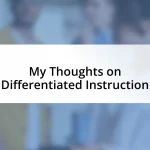Key takeaways:
- Participation enhances connection, ownership, and motivates individuals, leading to collaborative outcomes and personal growth.
- Creating a safe and inclusive environment encourages diverse contributions and fosters deeper engagement among participants.
- Utilizing incentives and recognition can significantly boost motivation and encourage active participation in discussions.
- Measuring participation effectiveness helps identify improvement areas and adapt strategies for sustained engagement and inclusion.

Understanding the importance of participation
Participation is more than just a checkbox; it fosters connection and creates a sense of belonging. I remember a team project where half the group felt sidelined. As we began to actively include everyone in discussions, the energy shifted. Suddenly, those who were quiet started sharing insightful ideas, and it transformed our outcome. Isn’t it interesting how inclusion can unlock creativity and collaboration?
When people participate, they take ownership of the process and outcomes, which can boost motivation and commitment. I witnessed this firsthand in a community workshop. Initially, attendance was low, but when the facilitators encouraged everyone to voice their opinions, the atmosphere changed. Participants became invested not only in their contributions but in each other’s perspectives. This sense of shared purpose is incredibly impactful, don’t you think?
Moreover, participation nurtures learning and growth. Those moments when I opted to step outside my comfort zone and contribute in team settings have been pivotal. I learned so much from others’ feedback, which helped me develop new skills and perspectives. How often do we miss opportunities for growth by staying silent? Embracing participation is an invaluable step towards collective progress.

Techniques to foster engagement
Techniques to foster engagement can make all the difference in creating a collaborative environment. One method I’ve found particularly effective is using open questions to stimulate conversation. In a recent brainstorming session, I posed an open-ended question about our project goals. The moment I did, I saw hesitations fade, and participants began to share their thoughts freely. It was as if a light bulb went off, igniting lively discussions that enriched our ideas.
Here are some techniques I recommend:
- Create a safe space: Encourage participants to express themselves without fear of judgment.
- Use icebreakers: Simple activities can ease tensions and foster rapport among team members.
- Incorporate various mediums: Whether it’s visual aids or hands-on activities, diverse formats can entice different learners.
- Invite feedback frequently: Actively asking for input helps everyone feel valued and part of the process.
- Celebrate contributions: Acknowledging individual efforts fosters pride and motivates ongoing participation.
I can’t stress enough how transformative it has been when I’ve actively sought feedback from my peers. For instance, during a project debrief, I decided to implement a suggestion box. The influx of ideas surprised me, sparking unexpected collaborations that redefined our approach. This experience taught me that empowering others to share their perspectives enriches the entire group dynamic.

Creating an inclusive environment
Creating an inclusive environment starts with recognizing that everyone has something valuable to offer. I recall a situation where I hosted a workshop, and I made a conscious effort to reach out to quieter participants. By gently encouraging them to share their thoughts, I noticed a shift in the room’s energy. Suddenly, voices that had been silent began to emerge, and the diversity of ideas led to richer discussions. It was a clear reminder that inclusivity not only benefits the group but also helps individuals find their own voices.
Another aspect that fosters inclusivity is establishing norms that prioritize respect and understanding. During one of our team meetings, I suggested implementing a ‘no interrupting’ rule. It might sound simple, but this small change created a sense of safety. As everyone took turns sharing, I could see the relief on some faces—those who had previously hesitated to speak up. The environment transformed, revealing deeper connections and insights among team members. Isn’t it remarkable how a slight adjustment can pave the way for greater participation?
Lastly, using visual cues or collaborative tools can strengthen inclusivity as well. I vividly remember introducing a digital whiteboard in a brainstorming session. Participants could contribute ideas simultaneously, which eliminated the pressure of speaking up in a crowded room. The excitement was palpable as people engaged with the content in real-time, leading to even more creative contributions. This firsthand experience highlighted how technology can enhance participation, helping us engage everyone, regardless of their comfort level.
| Approach | Impact |
|---|---|
| Encouraging quieter voices | Brings out diverse ideas and insights |
| Implementing respectful norms | Fosters a safe space for all participants |
| Utilizing collaborative tools | Enhances engagement and creativity |

Using incentives to motivate
When it comes to motivating participation, I’ve often turned to incentives as a powerful tool. For example, during a recent project kickoff, we introduced a friendly competition where team members could earn points for their contributions. The excitement in the room was contagious—everyone wanted to outdo each other, and I noticed that ideas flowed more freely as a result. Isn’t it fascinating how a small incentive can spark such enthusiasm?
I also learned that not all incentives have to be material; sometimes, recognition can be just as motivating. In one of my favorite team meetings, I highlighted individual achievements before diving into our agenda. I could see the pride shining in my colleagues’ eyes; it was a simple gesture but one that reinforced their commitment to the group. Have you ever considered how meaningful acknowledgment can be in a collaboration? It’s remarkable how a few words of appreciation can inspire others to contribute more actively.
Additionally, I’ve experimented with tiered incentives that cater to different interests. For instance, I once offered a choice of rewards—whether it be a gift card, a team lunch, or an extra day off. The diversity of options appealed to everyone, and I saw participants driven to work together more cohesively. This experience taught me a valuable lesson: when people feel like they have a stake in the rewards they receive, their motivation to participate often skyrockets. How could you use similar strategies in your own efforts to encourage participation?

Strategies for facilitating discussions
Facilitating discussions is an art, and I’ve found that asking open-ended questions can work wonders. For instance, in a team debrief, I once opened the floor with, “What surprised you the most about this project?” The room buzzed with energy as participants eagerly shared their thoughts. It’s incredible how such questions can unlock deeper insights, encouraging everyone to think critically and contribute meaningfully.
Another strategy that I’m quite passionate about is incorporating small group discussions before a full group share. I vividly remember a meeting where I divided participants into pairs to discuss their ideas for ten minutes. When we reconvened, the conversations were richer and more informed. The smaller setting allowed participants to express themselves without the intimidation of a larger audience. Have you ever noticed how comfort in smaller groups can amplify participation?
Finally, I love the idea of using storytelling to spark excitement. In a particularly memorable workshop, I shared a personal challenge related to our topic. As I recounted my experience, I saw participants nodding and relating their own stories. This emotional connection not only encouraged others to share but created a sense of community. Isn’t it amazing how vulnerability can foster openness in discussions? It’s these little moments that truly elevate the conversation to a more engaged and participatory level.

Measuring participation effectiveness
Measuring the effectiveness of participation can be quite revealing. I recall a time during a project when we used surveys to gauge how engaged team members felt after our meetings. The feedback was eye-opening; some felt they could contribute more but didn’t know how. This prompted me to reevaluate our approach by integrating targeted follow-up sessions, which made a noticeable difference.
In another instance, we implemented a simple metric: counting the number of ideas generated during brainstorming sessions. Surprisingly, the numbers spoke volumes. On days when I used techniques like round-robin sharing, we discovered that participation levels soared. What does that say about the need for varied methods in unlocking creativity? I’ve learned from these experiences that effective measurement goes beyond just numbers; it’s about understanding the feelings behind them.
I’ve also found it helpful to analyze the influence of participation on project outcomes. For example, in a recent initiative, tracking project milestones alongside participation levels revealed a direct correlation between high involvement and successful deliverables. Reflecting on this, I asked myself: How can we continuously adapt our strategies to ensure everyone feels empowered to participate? This ongoing process of measurement and reflection is crucial for fostering an inclusive environment.

Continuous improvement of participation methods
I always believe in the power of feedback as a tool for improvement. One time, after a particularly engaging workshop, I distributed a quick feedback form asking participants what aspects inspired their participation. The responses were illuminating; people expressed a desire for more interactive activities. This simple act of asking led me to revamp future sessions by incorporating more hands-on elements, which made a noticeable shift in engagement. Have you ever tried gathering feedback in a way that directly shapes your methods?
Another approach I’ve adopted is experimenting with different formats for participation. For instance, I once hosted a session that blended traditional presentations with live polls and real-time Q&A. The atmosphere lifted palpably as participants witnessed their opinions being reflected instantly on the screen. It was fascinating to see how technology not only enhanced the experience but also prompted more spontaneous contributions. I often wonder: how can we keep pushing the envelope to make participation feel more dynamic?
Continuous improvement also means staying abreast of new trends in facilitation. I recently attended a webinar on the gamification of discussions. Intrigued, I integrated some principles into our next meeting, transforming a mundane brainstorming session into a friendly competition. The energy shifted remarkably, making contributions feel more like a team effort than an obligation. Reflecting on this experience, I ask myself: what new strategies are out there waiting for us to explore, and how can they invigorate our next gathering?














